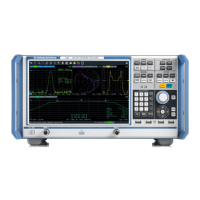GUI Reference
R&S
®
ZNB/ZNBT
400User Manual 1173.9163.02 ─ 53
The measurement is triggered according to the current trigger settings (see Chap-
ter 6.10.3, "Trigger Tab", on page 407). Each trigger event triggers the first partial
measurement of a measurement point. The time interval between two consecutive
measurements depends on the trigger settings and the sweep parameters (especially
the number of points). Any trigger mode is allowed.
A "CW Mode" sweep corresponds to the analysis of a signal over the time with a time
scale and resolution that is determined by the trigger events. In a Cartesian diagram,
the measurement result is displayed as a trace over a linear time scale (like, e.g., in an
oscilloscope). The diagram is similar to the "Time" diagram. The following example
shows a "CW Mode" sweep with a DUT that does not markedly change its transmis-
sion characteristics over the time.
Tip: Sweep time
The time interval between two consecutive trigger pulses must not be smaller than the
minimum measurement time per measurement point. See "Sweep Time / Auto"
on page 395.
Remote command:
[SENSe<Ch>:]SWEep:TYPE on page 1203 POINt
Time
"Time" sweeps, like CW Mode sweeps, are performed at constant frequency and stim-
ulus power, which can be specified in the "Stimulus" settings (see Chapter 6.8.1, "Stim-
ulus Tab", on page 384). A single sweep extends over a specified period of time,
defined via the "Stop Time" setting. The time intervals between two consecutive sweep
points are calculated according to "Stop Time"/(n - 1) where n is the selected Number
of Points.
A "Time" sweep corresponds to the analysis of a signal over the time; the function of
the analyzer is analogous to an oscilloscope. In a Cartesian diagram, the measure-
ment result is displayed as a trace over a linear time scale. The following example
shows a "Time" sweep with a DUT that does not markedly change its transmission
characteristics over the time.
Sweep Softtool

